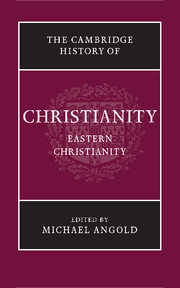Book contents
- Frontmatter
- PART I THE ECUMENICAL PATRIARCHATE
- PART II THE RUSSIAN CHURCH
- PART III EASTERN CHRISTIANITIES
- 16 Eastern Christianities (eleventh to fourteenth century): Copts, Melkites, Nestorians and Jacobites
- 17 The Armenians in the era of the crusades 1050–1350
- 18 Church and diaspora: the case of the Armenians
- 19 Church and nation: the Ethiopian Orthodox Täwahedo Church (from the thirteenth to the twentieth century)
- 20 Coptic Christianity in modern Egypt
- 21 Syriac Christianity in the modern Middle East
- PART IV THE MODERN WORLD
- Bibliography
- Index
- References
19 - Church and nation: the Ethiopian Orthodox Täwahedo Church (from the thirteenth to the twentieth century)
from PART III - EASTERN CHRISTIANITIES
Published online by Cambridge University Press: 28 March 2008
- Frontmatter
- PART I THE ECUMENICAL PATRIARCHATE
- PART II THE RUSSIAN CHURCH
- PART III EASTERN CHRISTIANITIES
- 16 Eastern Christianities (eleventh to fourteenth century): Copts, Melkites, Nestorians and Jacobites
- 17 The Armenians in the era of the crusades 1050–1350
- 18 Church and diaspora: the case of the Armenians
- 19 Church and nation: the Ethiopian Orthodox Täwahedo Church (from the thirteenth to the twentieth century)
- 20 Coptic Christianity in modern Egypt
- 21 Syriac Christianity in the modern Middle East
- PART IV THE MODERN WORLD
- Bibliography
- Index
- References
Summary
Ethiopia claims one of the oldest national traditions in Christendom. In the second quarter of the fourth century, the Ethiopian king, Ezana, together with his court, converted to Christianity. At the request of Ezana, St Athanasios, bishop of Alexandria, appointed Ethiopia’s first bishop. Royal initiative thus founded a national church episcopally dependent on Alexandria. We know little about the pace of popular conversion, but Christianity did become embedded in the farming communities of the Ethiopian highlands, where it remains a deeply popular religion. Royal dominance and popular commitment were the two poles of historic Ethiopian Christianity. Performing the role of mediator between these were, on the one hand, the Egyptian-appointed bishops, and on the other – and more importantly – the monasteries, which dotted the landscape, both geographical and cultural.
Ethiopian history unfolded on a high tablel and, much intersected by mountain ranges and deeply fissured river valleys, which, during the principal rains lasting from mid-June to mid-September, is extremely difficult to traverse. The Ethiopian plateau lies at the southern end of the Red Sea and at the headwaters of the Blue Nile, the source of Egypt’s annual flood. Christianity came to Aksum, then the principal town on the northern plateau, as part of the Hellenistic culture of the traders who plied the Red Sea in the early centuries of the era. The Aksumite kingdom was the most powerful state in the southern Red Sea, and the country remained sensitive to developments stemming from this direction. The highlands, which presented such a challenge to Ethiopia’s rulers, presented an even greater challenge to external powers, and afforded the country a degree of autonomy vis-à-vis the millennial forces which swept the region.
- Type
- Chapter
- Information
- The Cambridge History of Christianity , pp. 457 - 487Publisher: Cambridge University PressPrint publication year: 2006
References
- 1
- Cited by

